.

Theodoros Kolokotronis (Greek: Θεόδωρος Κολοκοτρώνης) (3 April 1770 – 4 February 1843) was a Greek Field Marshal and one of the leaders of the Greek War of Independence against the Ottoman Empire.

Signature of Theodoros Kolokotronis
Kolokotronis' greatest success was the defeat of the Ottoman army under Mahmud Dramali Pasha at Dervenakia in 1822. In 1825, he was appointed commander-in-chief of the Greek forces in the Peloponnese. Today Kolokotronis is among the most revered of the protagonists of the War of Independence.
Early life
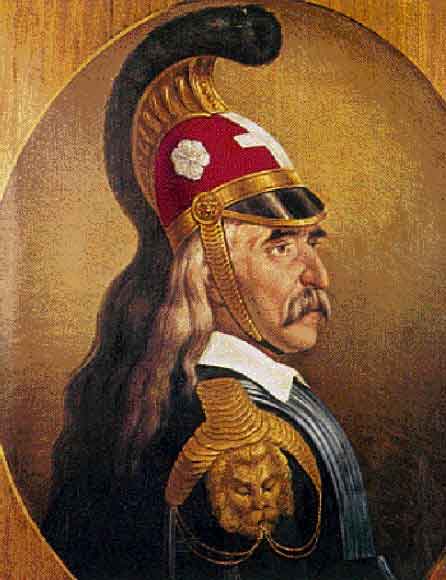
Kolokotronis was born at Ramavouni in Messenia, and grew up in Libovitsi in Arcadia. The Kolokotroneoi were a powerful and respected clan in Arcadia in the 18th century. Their legendary pride and insubordination is commemorated in a well-known folk song from that time:
Ahorse they go to church,
Ahorse they kiss the icons,
Ahorse they receive communion
From the priest's hand.
His father, Constantine Kolokotronis, took part in an armed rebellion which was supported by Catherine the Great of Russia, but was killed in an engagement along with two of his brothers George and Harry. Theodoros joined the ranks of a Peloponnesian guerrilla band, and by age fifteen was the leader (kapetanios, which means "captain") of his own group. He had a brief stint at sea as a corsair, then in 1805 he took service on a series of ships in the Russian fleet in the Russo-Turkish War. After 1810 he served in a corps of Greek infantry in British service on Zakynthos, then a British possession, and was awarded the brevet rank of brigadier for his service against the French. From his service in the regular Russian and British forces, Kolokotronis gained valuable insights that he would later use in his career.
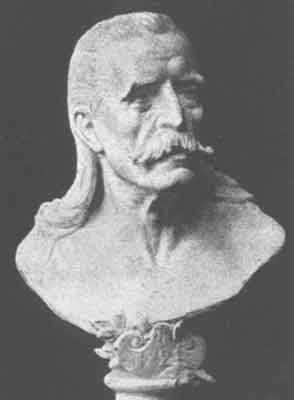
War of Independence
The Palamidi Castle at Nafplion.
Outbreak
Kolokotronis returned to the mainland just prior to the outbreak of the war (officially, 25 March 1821) and formed a confederation of irregular Moreot klepht bands. These he tried to train and organize into something resembling a modern army. In May, he was named archistrategos or Marshal Commander-in-Chief. He was already 50 years old by this time, a fact which contributed to his sobriquet O Geros tou Morea or "The Elder of Morea," whereby Morea was another name describing the Peloponnese. Kolokotronis' first action was the defense of Valtetsi, the village near Tripoli where his army was mustering.
Nafplion
He next commanded Greek troops in the siege of the coastal town of Nafplion. He took the port, and the Turkish garrison in the town's twin citadels was running low on supplies, but the disorganized Greek provisional government at Argos, just to the north, could not complete negotiations for its surrender before a large Ottoman force began marching southward to crush the rebels. Panicked, government officials abandoned Argos and began evacuations by sea at Nafplion. Only an under-strength battalion under Demetrios Ypsilantis remained to hold Larissa castle, the fortress of Argos.
Statue of Kolokotronis at Dervenakia.
As liberator
Kolokotronis gathered the klephts together to march to the relief of Ypsilantis. This was quite a feat in itself, considering the near-collapse of the government and the notoriously quarrelsome nature of the klephtic bands. Even the troublesome Souliotes lent a hand. The Ottoman army from the north commanded by Mahmud Dramali Pasha, after taking Corinth, had marched to the plain of Argos. The castle of Larissa was an excellent position, commanding the whole plain. To leave such a stronghold straddling Turkish supply lines was far too dangerous. Dramali would have to reduce the fortress before moving on. Scaling the cliffs, breaching the castle's stout walls, and overcoming its resolute defenders would be no easy task.
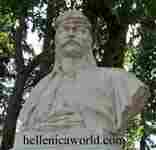
Yet, there was one weakness Dramali was unaware of: Larissa, unlike the famous Acropolis in Athens, had no spring and consequently fresh water had to be supplied from cisterns. Unfortunately for the Greeks, it was July and no rains were falling to fill the cisterns. Ypsilantis bluffed the Turks as long as he could, but towards the end of the month had to sneak his men out in the middle of the night. Dramali's men plundered the castle the next day, and he was now free to march them toward the coast to resupply. (The Greeks had pursued a scorched earth policy, and the large Ottoman force was eating through its food supplies rather quickly). Ypsilantis' defense had bought Kolokotronis and the klephts valuable time.
To his dismay, Dramali found himself cut off from his supply fleet, which had intended to land at Nafplio but was successfully blockaded by the Greek fleet under Admiral Andreas Miaoulis . Dramali reluctantly decided upon a retreat toward Corinth through the Dervenaki Pass, through which he had just come unmolested. This was exactly what Kolokotronis had been hoping for. In August 1822 his quicker-moving guerrilla forces trapped the Turks in the pass and annihilated them. A devastated Sultan Mahmud II in Constantinople was forced to turn to Muhammad Ali, ruler of the nominally Ottoman pashaluk of Egypt for help.
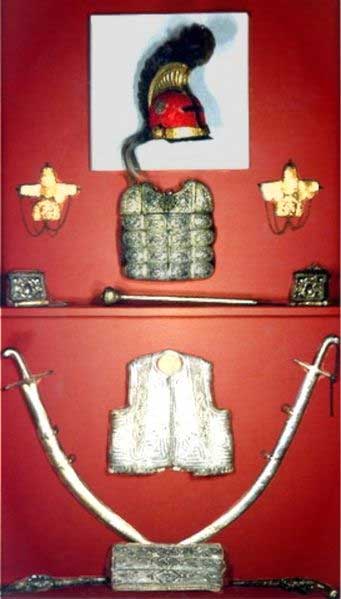
The weapons and armour of General Theodoros Kolokotronis (1770-1843)
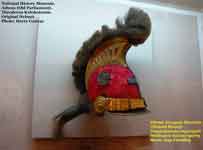
The Greeks resumed the siege against the fortresses at Nafplio, which fell in December. Kolokotronis is said to have ridden his horse up the steep slopes of Kastro Palamidi to celebrate his victory there; a statue in the town square commemorates the event. He is attired in something resembling the costume of a hussar topped with a plumed Corinthian helmet, which he was fond of wearing, and which foreign Philhellenes were even fonder of seeing him in. (While he seems to have enjoyed dressing like a Western European cavalryman cum Ancient Greek hoplite, he is also frequently depicted wearing the more traditional fustanella and other traditional accoutrements).
Parliamentary crisis
From December 1823 to February 1825, he took part in the civil wars between the various Greek factions; when his party was finally defeated, he was jailed in Hydra with some of his followers in March 1825, and was released only when an Egyptian army under the command of Ibrahim Pasha invaded the Morea.
Ibrahim's campaign
Ibrahim was fresh from fighting the Wahhabi rebels in Arabia, and so was used to fighting guerrillas. His troops were armed with the most modern equipment and trained by European experts. The sultan had promised his father the island of Crete as an appanage for young Ibrahim if he could crush the rebels. With his eye on the prize, he burned his way through the Peloponnese, gaining much territory but arousing much hostility in Western European public opinion, which in the long run proved disastrous for the Turks.
Statue of Kolokotronis in Athens.
Portrait of Kolokotronis used for the 5,000 drachma banknote.
The island of Sphacteria and Navarino had already fallen into Ibrahim's hands, and to make matters worse for Kolokotronis, he still had to be on guard against the machinations of Petrobey Mavromichalis even as he was bracing himself against the new threat. Kolokotronis used guerrilla tactics to wear Ibrahim's forces down; but given his limited resources, was unable to prevent the widespread destruction that Ibrahim left in his wake. Still, in 1825, in recognition of his military acumen and many services to the Greek cause, he was appointed commander-in-chief of Greek forces in the Peloponnese.
Postbellum activities
After the war Kolokotronis became a supporter of Count Ioannis Kapodistrias and a proponent of alliance with Russia. When the count was assassinated on 8 October 1831, Kolokotronis created his own administration in support of Prince Otto of Bavaria as a king of Greece. However, later he opposed the Bavarian-dominated regency during his rule. He was charged with treason and on 7 June 1834 sentenced to death; but he was pardoned in 1835. Theodoros Kolokotronis died in 1843 in Athens one day after his son's Konstantinos(Kollinos) wedding.
Theodoros Kolokotronis Statue, Athens :

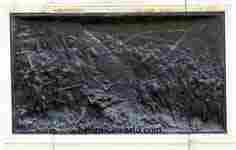

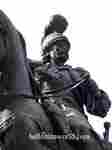
Theodoros Kolokotronis, Theodoros Kolokotronis, Theodoros Kolokotronis, Theodoros Kolokotronis,

Statue of Theodoros Kolokotronis, Tripolis
Epilogue
In the twilight of his life, Kolokotronis had learned to write in order to complete his memoirs, which have been a perennial favorite in Greece and have been several times translated into English and other languages. Kolokotronis' famed helmet, along with the rest of his arms and armor, may today be seen in the National History Museum of Greece in Athens. In addition to the Nafplio statue mentioned earlier, there is another to be seen in Athens, in the forecourt of the Old Parliament building on Stadiou Street, near Syntagma Square.
Legacy

Theodoros Kolokotronis, Karl Pavlovich Bryullov
Kolokotronis is also the name of military barracks near Tripolis. Κοlokotronis was so famous in popular culture that one can find references about him in strange places like a gravure sculpted by knife on a stony sterna inside a cave in one of the holes in mount Ntaouli opposite the village Lyrkeia in the valley of river Inarhos. Kolokotronis' portrait was depicted on the obverse of the Greek 5000 drachmas banknote of 1984-2001.[1]
In popular culture
References
^ Bank of Greece. Drachma Banknotes & Coins: 5000 drachmas. – Retrieved on 27 March 2009.
Further reading
Brewer, David L. The Greek War of Independence: The Struggle for Freedom from Ottoman Oppression and the Birth of the Modern Greek Nation. Woodstock & New York, Overlook Press: 2001.
Kolokotronis, Theodoros. Memoirs from the Greek War of Independence, 1821–1833 Argonaut Publishers: 1969.
Kolokotronis, Theodoros (translated by Elizabeth M. Edmonds). The Old Man of the Morea: An Autobiography. Reprint. Boston, Holy Cross Orthodox Press: 1984.[1]
External links
Kolokotronis at the Arcadia Page at the University of Patras (Greek)
vte
Greek War of Independence (1821–1829)
Background
Ottoman Greece
People
Armatoloi Proestoi Klephts Dionysius the Philosopher Daskalogiannis Panagiotis Benakis Konstantinos Kolokotronis Lambros Katsonis Cosmas of Aetolia Ali Pasha Maniots Phanariots Souliotes Gregory V of Constantinople
Events
Orlov Revolt Souliote War (1803)
Greek Enlightenment
People
Athanasios Christopoulos Theoklitos Farmakidis Rigas Feraios Anthimos Gazis Theophilos Kairis Adamantios Korais Eugenios Voulgaris
Organizations
Ellinoglosso Xenodocheio Filiki Eteria
Nikolaos Skoufas Athanasios Tsakalov Emmanuil Xanthos Panagiotis Anagnostopoulos Philomuse Society Society of the Phoenix
Publications
Adelphiki Didaskalia Asma Polemistirion Hellenic Nomarchy Pamphlet of Rigas Feraios Salpisma Polemistirion Thourios or Patriotic hymn
European intervention and
Greek involvement in
the Napoleonic Wars
Russo-Turkish War (1768–1774) Treaty of Küçük Kaynarca Greek Plan of Catherine the Great Russo-Turkish War (1787–1792) French Revolution and Napoleonic Wars
Fall of the Republic of Venice Republican French rule in the Ionian Islands Septinsular Republic Greek Legion Imperial French rule in the Ionian Islands Albanian Regiment Adriatic campaign of 1807–1814 1st Regiment Greek Light Infantry United States of the Ionian Islands
Ideas
Nationalism Eastern Orthodox Christianity Liberalism Constitutionalism
Events
Sieges
Patras Salona Navarino Livadeia 1st Acropolis Tripolitsa Arta Acrocorinth Nauplia 1st Messolonghi 2nd Messolonghi 3rd Messolonghi 2nd Acropolis
Battles
Kalamata Wallachian uprising Alamana Gravia Valtetsi Doliana Lalas Vasilika Dragashani Sculeni Vasilika Trench Peta Dervenakia Karpenisi Greek civil wars Sphacteria Maniaki Lerna Mills Mani Distomo Arachova Kamatero Phaleron Chios expedition Martino Koronisia Petra
Massacres
Constantinople Thessaloniki Navarino Tripolitsa Naousa Samothrace Chios Psara Kasos
Naval conflicts
Eresos Chios Nauplia Samos Andros Sphacteria Gerontas Souda Alexandria Volos Itea Navarino
Ships
Greek sloop Karteria Greek brig Aris
Greek regional councils and statutes
Messenian Senate Directorate of Achaea Peloponnesian Senate Senate of Western Continental Greece Areopagus of Eastern Continental Greece Provisional Regime of Crete Military-Political System of Samos
Greek national assemblies
First (Epidaurus) (Executive of 1822) Second (Astros) Third (Troezen) Fourth (Argos) Fifth (Nafplion)
International Conferences,
Treaties and Protocols
Congress of Laibach Congress of Verona Protocol of St. Petersburg (1826) Treaty of London Conference of Poros London Protocol of 1828 London Protocol of 1829 Treaty of Adrianople London Protocol of 1830 London Conference Treaty of Constantinople
Related
Greek expedition to Syria (1825) Russo-Turkish War (1828-29)
Personalities
Greece
Chian Committee Odysseas Androutsos Anagnostaras Markos Botsaris Laskarina Bouboulina Constantin Denis Bourbaki Hatzimichalis Dalianis Kanellos Deligiannis Athanasios Diakos Germanos III of Old Patras Dimitrios Kallergis Athanasios Kanakaris Constantine Kanaris Ioannis Kapodistrias Stamatios Kapsas Panagiotis Karatzas Georgios Karaiskakis Nikolaos Kasomoulis Ioannis Kolettis Theodoros Kolokotronis Georgios Kountouriotis Antonios Kriezis Nikolaos Kriezotis Kyprianos of Cyprus Georgios Lassanis Lykourgos Logothetis Andreas Londos Yannis Makriyannis Manto Mavrogenous Alexandros Mavrokordatos Petrobey Mavromichalis Andreas Metaxas Andreas Miaoulis Theodoros Negris Nikitaras Antonis Oikonomou Ioannis Orlandos Papaflessas Dimitrios Papanikolis Emmanouel Pappas Christoforos Perraivos Nikolaos Petimezas Panagiotis Rodios Georgios Sachtouris Georgios Sisinis Iakovos Tombazis Anastasios Tsamados Meletis Vasileiou Demetrios Ypsilantis
Philhellenes
António Figueira d'Almeida Michail Komninos Afentoulief Joseph Balestra Lord Byron François-René de Chateaubriand Richard Church Giuseppe Chiappe Lord Cochrane Vincenzo Gallina Charles Fabvier Thomas Gordon Frank Abney Hastings Carl von Heideck Vasos Mavrovouniotis Johann Jakob Meyer
Ellinika Chronika Karl Normann Maxime Raybaud Giuseppe Rosaroll Santorre di Santa Rosa Friedrich Thiersch Auguste Hilarion Touret German Legion [el] Serbs Olivier Voutier
Moldavia and Wallachia
(Danubian Principalities)
Alexander Ypsilantis Sacred Band Nikolaos Ypsilantis Alexandros Kantakouzinos Georgios Kantakouzinos Athanasios Agrafiotis Giorgakis Olympios Yiannis Pharmakis Dimitrie Macedonski Tudor Vladimirescu Konstantinos Xenokratis Anastasios Manakis Stamatios Kleanthis
Ottoman Empire, Algeria, and Egypt
Sultan Mahmud II Hurshid Pasha Nasuhzade Ali Pasha Ismael Gibraltar Omer Vrioni Kara Mehmet Mahmud Dramali Pasha Koca Hüsrev Mehmed Pasha Reşid Mehmed Pasha Yussuf Pasha Ibrahim Pasha Soliman Pasha al-Faransawi
Britain, France and Russia
George Canning Stratford Canning Edward Codrington Henri de Rigny Lodewijk van Heiden Alexander I of Russia Nicholas I of Russia
Financial aid
London Philhellenic Committee Ludwig I of Bavaria Jean-Gabriel Eynard Lazaros Kountouriotis Ioannis Papafis Georgios Stavros Ioannis Varvakis Rothschild & Co
Morea expedition
Military
Nicolas Joseph Maison Antoine Simon Durrieu Antoine Virgile Schneider Auguste Regnaud de Saint-Jean d'Angély Camille Alphonse Trézel
Scientific
Jean Baptiste Bory de Saint-Vincent Léon-Jean-Joseph Dubois Pierre Peytier Stamatis Voulgaris Guillaume-Abel Blouet Gabriel Bibron Prosper Baccuet Eugène Emmanuel Amaury Duval Pierre-Narcisse Guérin Charles Lenormant Edgar Quinet
Historians/Memoirists
Dimitrios Ainian Fotis Chrysanthopoulos Ioannis Filimon George Finlay Ambrosios Frantzis Konstantinos Metaxas Panoutsos Notaras Panagiotis Papatsonis Anastasios Polyzoidis Georgios Tertsetis Spyridon Trikoupis
Art
Eugène Delacroix Louis Dupré Peter von Hess Victor Hugo François Pouqueville Alexander Pushkin Karl Krazeisen Andreas Kalvos Dionysios Solomos Theodoros Vryzakis Hellas The Reception of Lord Byron at Missolonghi Greece on the Ruins of Missolonghi Le siège de Corinthe The Massacre at Chios The Free Besieged Hymn to Liberty The Archipelago on Fire Loukis Laras The Apotheosis of Athanasios Diakos
Remembrance
25 March (Independence Day) Hymn to Liberty Eleftheria i thanatos Pedion tou Areos Propylaea (Munich) Garden of Heroes (Missolonghi) Royal Phalanx Evzones (Presidential Guard)
| Ancient Greece
Science, Technology , Medicine , Warfare, , Biographies , Life , Cities/Places/Maps , Arts , Literature , Philosophy ,Olympics, Mythology , History , Images Medieval Greece / Byzantine Empire Science, Technology, Arts, , Warfare , Literature, Biographies, Icons, History Modern Greece Cities, Islands, Regions, Fauna/Flora ,Biographies , History , Warfare, Science/Technology, Literature, Music , Arts , Film/Actors , Sport , Fashion --- |
Retrieved from "http://en.wikipedia.org"
All text is available under the terms of the GNU Free Documentation License

